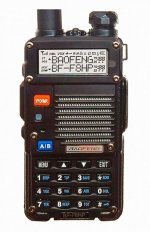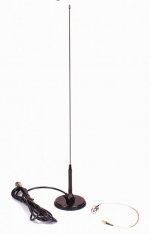Welcome to the Fourm.
1. Did you look up the 2 meter (144MHz) and 70 Cm (440MHZ) repeaters for the area you live in?
2. Depending on the area you live in the range can be from 15 to over 30 miles for the coverage area.
3. What area do you live in? Simple answer City and State.
Morning...Yes, I've tried everything - still able only to program in and receive the NOAA Weather, which I like and enjoy, yet - I'd really like to be able to listen in to something else?
Appreciate your suggestions, thanks...
Depending on where you are using a better aftermarket antenna can overload the receiver to where it won't pick up anything but very strong nearby stations.
Program the NOAA weather channels and see if you hear anything. Use the stock Baofeng antenna first and then see if the radio is deaf with the Nagoya.
Do you have another real radio or a scanner that you can listen to active frequencies on the Baofeng and the other radio at the same time?
The other possibility is the ham and GMRS repeaters in your area have no activity 90% of the time. That is if you programmed the correct ones.
Post the list of frequencies or link where you got the "Most Popular" frequencies. It could be totally useless BS from some YouTube influencer or prepper blog.
Morning...No, I don't have a scanner, etc.
I was able to program in the NOAA weather, it's great and I enjoy it but sure would like to be able to listen in to other transmissions.
I'm mostly confined to home these days as I mentioned, and I was eager to maybe find something really interesting like this that I could pursue, but afraid it's been very disappointing.
Yes, as you say - it's likely that 90% of the time there aren't any other operators "On the air."
I have this "Mobile" antenna with the magnetic base...I've tried it on top of the 'fridge, and a couple other places. It does bring the NOAA broadcasts somewhat better.
Perhaps my very location here near the shore of lake Ontario is just not a good location for reception... appreciate your response...thanks...
If you are a newbie with limited or zero radio knowledge then they are both horrendous if you don't know what you are doing. You need to know what all the radio settings and menus do and you need to know what all the fields in CHIRP do and what to put in them.
Baofengs are just as easy to program from the keypad as Alinco, Icom, Kenwood and Yaesu HTs.
Morning...I just now found these responses... appreciate!
I was looking at a YouTube video where someone is selling a plug-in "Frequency Stick" that has all of the available frequencies...not sure if it's for real or not.
I'm going to search around some more for more info.
I wonder if it's just my location? I'm near the shore of lake Ontario, I actually thought this would be a good thing, though? Thought maybe I'd be able to pick up some conversations from across in Ontario, Canada?
In anticipation of studying and acquiring a Tech license, I did the same thing you did. Bought a Baofeng UV-5R - to begin my education into Amateur Radio - bought the correct cable, and programmed the radio with Chirp for scanning: mostly Police, Fire, EMS, and a few other agencies, plus some local Ham.
I wasn’t getting much activity on the Ham repeaters but did get a lot for police, fire etc. Scanning speed is slow however.
In the meantime, I bought a Yaesu FT-60 and used it in a similar way but now mostly use it to communicate on 2m and 70cm.
I actually found active repeaters by scanning on a Uniden Bearcat 125AT and use that as a tool to discover active repeaters and program them in to my Baofeng and Yaesu.
I am fortunate that most agencies in my area are still analog.
As others have said, I would look up the frequencies and modes you are interested in for your area to get an idea what’s out there.
You might enjoy a dedicated scanner better - depending on your budget.
Morning... Appreciate your response, I'm just now seeing these as I've been a bit out of commission w/ some health issues.
It would be great if like you've done, programming in all of the usual scanner frequencies with my laptops, then using it like a scanner. Unfortunately, I still haven't been able to listen to a thing other than the NOAA that I was able to program in.
I thought my location here near the shore of lake Ontario might be enabled me to even listen in to some Canadian transmissions but no, nothing. Wicked disappointing and yes - perhaps I'd be better off with purchasing a regular "Scanner," but I really liked the idea of being able to transmit too.
I'm going to get my Baofeng back out and will keep trying.
Last evening I watched a YouTube video where a fellow is selling a "Frequency Stick" that will load all of the frequencies for fire, police, and so on into my laptop, and then I could somehow "Load" these onto my radio as I did purchase to necessary cord for my laptop...however, I'm not sure if this "Stick" is for real. I'll hunt around and see if any others have purchased it and found that it really works...
I'm not sure what "most popular" ham frequencies, but you might want to take a look at this list:
Or, non-ham frequencies here:
Scanner Frequencies and Radio Frequency Reference for Monroe County, New York (NY)
www.radioreference.com
I'll second trying NWS stations near you to make sure you're reciving at all.
Appreciate, thank you...will do...
If you're trying to monitor non-repeater (simplex) frequencies, such as 146.520 or 446.000, your antenna might not be high enough to hear these "line-of-sight" signals. If you're trying to monitor local repeater frequencies, be aware that many ham repeaters might not have much activity... especially during working hours. There may be only one or two fairly active repeaters in your area. Other listed repeaters might not have such good coverage, might be out of service, or might not actually exist. Try listening during the late afternoon/early evening "drive times" for more activity.
Finally, see if you can hear a local NOAA/weather radio channel or other known-good channel... just to confirm that your receiver is working properly. Baofeng has a less-than-stellar reputation for quality control.
Thanks, will try this.
Yeah - these Baofeng radios are the inexpensive, budget models!
It might be helpful too if you can find a local ham or club. Theres usually people that can help with this stuff at local radio clubs.
Morning, yes - I've been down w/ some health issues but hope soon to look into some of the local radio clubs. It'd be nice just to connect with some other folks that are interested in the radio realm...
Near the lakes, you might try programming in the VHF marine frequencies, or at least channels with activity.
Don't let the learning curve of programming your radio, or the new world of amateur, discourage you. It can take time and patience.
Deffinately, local ham clubs are a great place to start.
Welcome to the new world.
Morning...
Thanks, Merlin.
I'm going to give this a try, the marine frequencies...and, have been looking into some of the local radio clubs as I think it'd be great to be able to connect w/ some others with interests in HAM, etc. radio...



